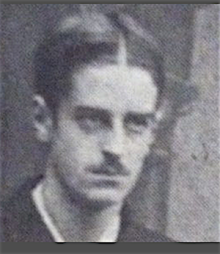
Edmund Hamilton Rathbone was born in Toxteth Park, Lancashire, England on 3 September 1863, and was the son of Philip Henry Rathbone (1828-1895), a prominent Liverpool merchant and patron of the arts. By the late 1880s he was practising as an architect in the Liverpool area, however, it is not known where or with whom he trained in the profession. Among his architectural projects were the design of the Memorial Church on Manor Road, Wallasey (1898-99), with Edmund Ware (1852–1934) [1], and the remodelling of the interior of the Liverpool Medical Institution and the interior of Sefton Court in Croxteth Gate, Liverpool (c.1901).
He also designed ceramics for Della Robbia Pottery, which had been founded by his brother, Harold Steward Rathbone (1858-1929) in 1894. Between 1891 and 1914 he exhibited at the Walker Art Gallery in Liverpool; and at the Royal Scottish Academy in Edinburgh. He also participated in the 5th exhibition of the Arts & Crafts Exhibition Society in London in 1896 at which he exhibited a frieze entitled "Doy and Grapes" he designed for the Della Robbia Pottery.
Like his father and his brother Harold, he was a member of the Century Guild of Artists, an arts and craft guild founded in 1882 by Arthur Heygate Mackmurdo (1851-1942), and was their representative in Liverpool. During his association with the Guild he designed furniture [2].
He organised the ‘Aesthetic Fair Loan Art Collection’ held in Liverpool in 1896 which featured works by Dante Gabriel Rossetti and James McNeill Whistler. He also he ran The City Beautiful Wayside Café, a meeting place for Liverpool’s artistic elite. He was the author of a pamphlet entitled ‘Humanity and Art’, and was a poet.
His address was given as "Greenbank Cottage", Wavertree, near Liverpool in 1891; 51 Hope Park, Liverpool in 1901; and 9 Bedford Street, Liverpool in 1911. The 1921 England census records that he was a patient in the "Convalescent Branch of Camberwell House Asylum London Se Hove Villa Dyke Road, Steyning, Sussex", where it would seem he died on 2 April 1924
______
[1] or Frederick Waring - sources differ.
[2] Two chairs believed to have been designed by him for the study library of Dr Joseph Wiglesworth at the then Lancashire County Lunatic Asylum are illustrated Arts and Crafts Pioneers: The Hobby Horse Men and their Guild by Stuart Evans and Jean Liddiard (London: Lund Humphries, 2021 pp. 152, 153)
Evans, Stuart and Liddiard, Jean. Arts and Crafts Pioneers: The Hobby Horse Men and their Guild. London: Lund Humphries, 2021
Sharples, Joseph. Liverpool: Buildings of England. New Haven: Yale University Press, 2004.